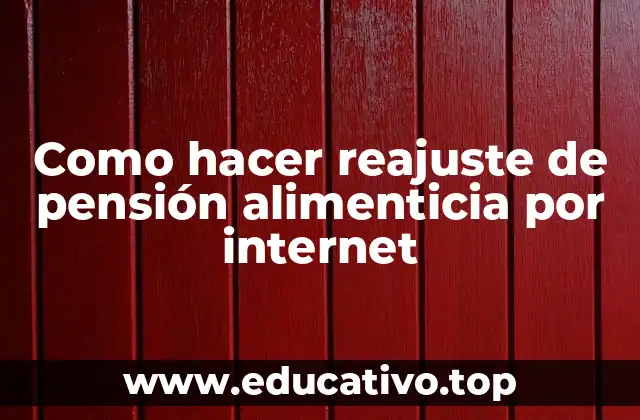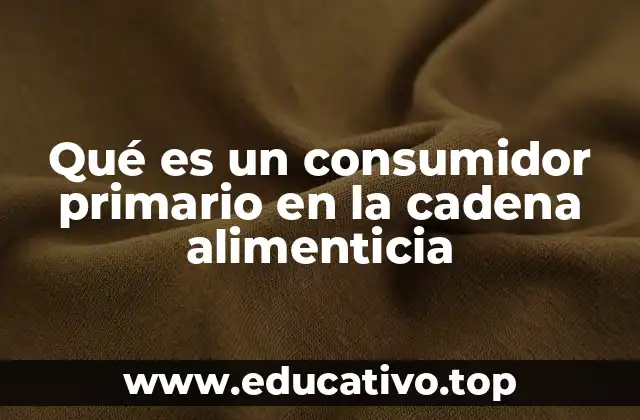La cadena alimenticia es un concepto fundamental en biología y ecología que describe cómo el flujo de energía se transmite entre los organismos en un ecosistema. En inglés, se conoce como food chain, y es una herramienta clave para entender las interacciones entre productores, consumidores y descomponedores. A través de este artículo exploraremos en detalle qué es una food chain, cómo se estructura, su importancia y ejemplos prácticos, todo en el idioma inglés.
¿Qué es una food chain?
Una food chain (cadena alimenticia en inglés) es una secuencia lineal que muestra cómo la energía y los nutrientes fluyen entre diferentes organismos en un ecosistema. Comienza con los productores, generalmente plantas que realizan la fotosíntesis, y continúa con consumidores primarios, secundarios y, en algunos casos, terciarios. Finaliza con los descomponedores, que se encargan de reciclar los materiales orgánicos.
Por ejemplo, en una típica cadena alimenticia de un bosque, podríamos encontrar:planta → ciervo → lobo → hongo. Cada nivel transmite energía al siguiente, aunque con pérdidas significativas en cada paso.
Además de su utilidad educativa, la food chain también ayuda a los científicos a predecir los efectos de cambios ecológicos. Por ejemplo, si se elimina un depredador clave, como el lobo, podría desencadenar un aumento en la población de ciervos, lo que a su vez afectaría a la vegetación y al resto de la cadena.
Understanding the Flow of Energy in Food Chains
The flow of energy in a food chain is unidirectional and becomes increasingly inefficient as it moves from one trophic level to the next. This inefficiency is due to the Second Law of Thermodynamics, which states that energy is lost as heat at each transfer. Typically, only about 10% of the energy is passed on to the next level. This is known as the 10% Rule, and it explains why food chains are generally short and rarely have more than four or five links.
Furthermore, food chains are simplified models. In reality, ecosystems are more complex and interconnected, which is why scientists often use food webs to better represent the multiple interactions between species. These webs illustrate the intricate relationships and overlapping roles that organisms play in an ecosystem.
The Role of Producers in Food Chains
Producers, or autotrophs, are the foundation of every food chain. They convert solar energy into chemical energy through photosynthesis, creating organic compounds that fuel the rest of the ecosystem. In marine environments, producers like phytoplankton serve the same role as terrestrial plants. Without producers, there would be no food for consumers, and the entire food chain would collapse.
These organisms not only provide food but also oxygen to the atmosphere, making them essential for sustaining life on Earth. Their health and abundance directly impact the stability of the entire food chain. Environmental stressors such as pollution, deforestation, or climate change can severely affect producers, leading to cascading effects on higher trophic levels.
Examples of Food Chains in Different Ecosystems
Food chains vary depending on the ecosystem they are found in. In a terrestrial ecosystem, a common example is:
Grass → Grasshopper → Mouse → Snake → Hawk.
In a marine ecosystem, the chain might look like:
Phytoplankton → Zooplankton → Small Fish → Tuna → Shark.
In desert ecosystems, a typical food chain could be:
Cactus → Insect → Lizard → Snake → Hawk.
Each of these examples demonstrates how energy is transferred from one organism to another. It’s important to note that while these are simplified models, they help in understanding the basic structure and function of food chains in different environments.
The Concept of Trophic Levels
Trophic levels are the different positions an organism occupies in a food chain. There are four main levels:
- Producers – Organisms that make their own food (e.g., plants, algae).
- Primary Consumers – Herbivores that eat producers (e.g., deer, grasshoppers).
- Secondary Consumers – Carnivores that eat primary consumers (e.g., frogs, small fish).
- Tertiary Consumers – Top carnivores that eat secondary consumers (e.g., eagles, sharks).
After these, there are decomposers such as fungi and bacteria that break down dead material, returning nutrients to the soil or water. Understanding trophic levels is essential for analyzing the flow of energy and the balance within ecosystems.
Top 5 Common Food Chains in Nature
Here are five of the most commonly studied food chains in nature:
- Grass → Rabbit → Fox → Eagle
- Algae → Zooplankton → Small Fish → Salmon → Bear
- Corn → Mouse → Snake → Hawk
- Seaweed → Clam → Oyster Catcher → Eagle
- Cactus → Insect → Lizard → Snake → Hawk
These food chains are often used in classrooms to teach students about ecological relationships and energy transfer. They are also useful in scientific research to model ecosystem dynamics and the impact of human activities such as deforestation and overfishing.
The Importance of Food Chains in Ecosystems
Food chains play a crucial role in maintaining the balance of ecosystems. They help regulate population sizes, ensuring that no single species becomes too dominant. For instance, if the population of a primary consumer increases, it can lead to overgrazing or overconsumption of producers, which in turn affects the entire chain.
Moreover, food chains are indicators of ecosystem health. A diverse and stable food chain suggests a healthy ecosystem, while a disrupted or simplified chain may signal environmental stress or degradation. Monitoring food chains can help scientists detect early signs of ecological imbalance and take corrective actions.
¿Para qué sirve una food chain?
Una food chain sirve para representar visualmente cómo se transmite la energía entre los organismos en un ecosistema. Su principal utilidad es educativa y científica, ya que permite entender las relaciones entre diferentes especies y el flujo de energía. También se usa para predecir los efectos de cambios ecológicos, como la extinción de una especie o la introducción de una nueva.
Además, las food chains son herramientas clave en la gestión de recursos naturales. Por ejemplo, en la pesca sostenible, se analizan las cadenas alimenticias para evitar la sobreexplotación de especies clave. En agricultura, se usan para promover prácticas que mantengan el equilibrio entre cultivos y plagas naturales.
Alternative Terms for Food Chain
While food chain is the most common term, there are several related terms that are also used in ecological studies:
- Food Web: A more complex model that shows multiple interactions between species.
- Energy Pyramid: A graphical representation of the energy distribution across trophic levels.
- Trophic Chain: A scientific term that refers to the same concept as food chain.
- Ecological Chain: A broader term that includes both food chains and other ecological relationships.
Each of these terms serves a slightly different purpose, but they are all interconnected in the study of ecosystems.
The Interconnectedness of Food Chains
Food chains are not isolated; they are part of a larger network known as a food web. In reality, organisms do not feed in a linear fashion. A single species may be both a primary consumer and a secondary consumer, depending on the food source. For example, a bird may eat insects (making it a secondary consumer) and also eat seeds (making it a primary consumer).
This interconnectedness is vital for ecosystem resilience. If one species is removed, others can often compensate, maintaining the flow of energy. However, the more specialized a food web is, the more vulnerable it becomes to disturbances. This is why biodiversity is so important for the stability of ecosystems.
What Does a Food Chain Mean?
A food chain is a representation of the energy flow in an ecosystem. It shows how organisms are connected through feeding relationships, from producers at the base to top predators at the top. The concept is central to ecology because it helps explain how energy is transferred and how ecosystems function.
In a food chain, each link represents a trophic level, and each level depends on the one before it for energy. The first level consists of producers, the second of primary consumers, the third of secondary consumers, and so on. The efficiency of energy transfer is low at each level, which is why food chains are usually short.
What is the Origin of the Term Food Chain?
The term food chain was first coined in the early 20th century by ecologists who were studying the relationships between species in ecosystems. The concept was influenced by Charles Darwin’s theory of evolution and the work of ecologists like Charles Elton, who introduced the idea of trophic dynamics.
The word chain was chosen to represent the linear sequence of feeding relationships, where each organism is a link that transfers energy to the next. The term became widely used in the mid-20th century as ecological science developed further and became more integrated into environmental education.
Alternative Phrases for Food Chain
In addition to food chain, there are several other expressions that can be used depending on the context:
- Energy flow diagram: Focuses on the movement of energy rather than the organisms themselves.
- Ecological chain: A broader term that includes both food chains and other ecological interactions.
- Feeding relationships: A general term used in ecological studies to describe how organisms interact through consumption.
- Trophic sequence: A scientific term that describes the same concept in a more formal context.
Each of these phrases has its own nuances and is used in different contexts depending on the level of detail and the audience being addressed.
How to Describe a Food Chain in English
To describe a food chain in English, you can follow this simple structure:
- Start with the producer.
- Mention the primary consumer.
- Add the secondary consumer.
- Include the tertiary consumer, if applicable.
- End with the decomposers.
For example:
The food chain in this forest ecosystem begins with trees, followed by deer, then wolves, and finally decomposers like fungi.
You can also use verbs like eats,is eaten by,feeds on, or is consumed by to describe the relationships between organisms.
How to Use the Term Food Chain in Sentences
Here are some examples of how to use the term food chain in English sentences:
- The food chain in the ocean is more complex than in terrestrial environments.
- Understanding the food chain helps students grasp how ecosystems function.
- Human activities can disrupt the food chain, leading to imbalances in nature.
- The introduction of an invasive species can alter the food chain dramatically.
These examples show how versatile the term is in both scientific and educational contexts.
The Environmental Impact of Disrupted Food Chains
Disruptions in food chains can have severe consequences for ecosystems. For instance, if a key predator is removed, it can lead to an overpopulation of its prey, which in turn can overgraze vegetation and cause habitat degradation. This phenomenon is known as a trophic cascade.
Another example is the overfishing of top predators like sharks, which can lead to an increase in their prey, such as rays, which then overgraze shellfish populations. This can result in the collapse of entire fisheries. Therefore, maintaining the integrity of food chains is essential for preserving biodiversity and ecosystem health.
The Role of Humans in Food Chains
Humans are not just passive observers of food chains; they are active participants. As omnivores, humans consume both plants and animals, placing them at various levels in the food chain. However, human activities such as agriculture, deforestation, and pollution have a significant impact on food chains.
For example, the use of pesticides can reduce insect populations, which affects the birds and small mammals that depend on them for food. Similarly, overhunting can remove key species from food chains, causing imbalances. Understanding our role in food chains is essential for promoting sustainable living and protecting ecosystems.
Lucas es un aficionado a la acuariofilia. Escribe guías detalladas sobre el cuidado de peces, el mantenimiento de acuarios y la creación de paisajes acuáticos (aquascaping) para principiantes y expertos.
INDICE









